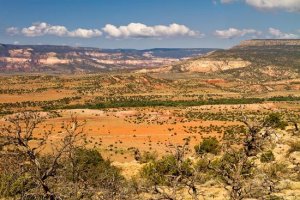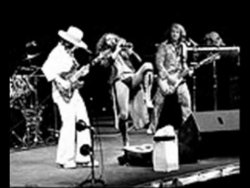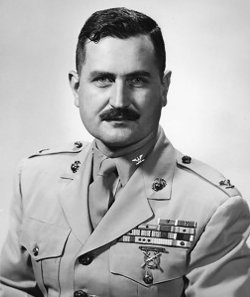Background information. Continue reading
Climate: New Mexico is a very big state, and most of it is desert. Albuquerque, its largest city and by far the most developed area in the state, averages only 9.5 inches of rain per year! When I arrived in Albuquerque there had been no measurable precipitation in eight months.
On most days it was sunny and windy with very low humidity. One day the wind was blowing so hard on the golf course that balls that had come to a stop on the green were subsequently blown down to the fringe. Rain does not come to New Mexico often, but when it does, it usually arrives via a tremendous storm that deposits copious amounts of water for a short time.
 Grass or almost any vegetation can grow there, but it must be watered every day. If not, the land will quickly revert to the desert scrub that people in those days called “mesa’. It was more like very rough sand than dirt. A few native plants can survive in it. Golf balls hit beyond the rough that was watered every day ended up on the mesa. Hitting the ball out of the mesa is possible, but one’s clubs get badly scratched very quickly.
Grass or almost any vegetation can grow there, but it must be watered every day. If not, the land will quickly revert to the desert scrub that people in those days called “mesa’. It was more like very rough sand than dirt. A few native plants can survive in it. Golf balls hit beyond the rough that was watered every day ended up on the mesa. Hitting the ball out of the mesa is possible, but one’s clubs get badly scratched very quickly.
 During a storm it becomes evident that some parts of the sand are not packed as tightly as they appeared. Rivulets, called wadis, can suddenly appear out of nowhere. One on the southeast side of Sandia Base was several feet deep, and it appeared repeatedly during my sojourn there. During dry periods the land looked flat.
During a storm it becomes evident that some parts of the sand are not packed as tightly as they appeared. Rivulets, called wadis, can suddenly appear out of nowhere. One on the southeast side of Sandia Base was several feet deep, and it appeared repeatedly during my sojourn there. During dry periods the land looked flat.
When I first arrived, I felt that I could understand why pioneers came to New Mexico, but I could not understand why they stopped there. However, by the time that I left I did not find the adjustments as burdensome as they initially seemed. Exercising outdoors required a few precautions to avoid sunburn and dehydration. Since these were necessary all year long, most people became used to them. The big plus was that outdoor events can be planned with little worry of the weather. Home games of the Albuquerque Dodgers are seldom rained out. For me the summer weather was like KC but more so. I did not really experience one, but I suspect that the winters were a good deal milder than those in KC.
 Morale: The climate in the Pentagon in 1971 was stormy all year. Morale in the armed forces, especially the Army, was the lowest ever. The War in Vietnam was supposedly “winding down,” and the Army was told that in 1971 and future years fewer troops would be allowed. Early in the year the details of the “Reduction in Force” were still being worked out. Rumors abounded, but a persistent one, which turned out to be true, was that all draftees would have their active duty requirement shortened by from two years to only eighteen months. In addition a lot fewer men (and, of course, no women) were drafted in 1971 than in 1970.
Morale: The climate in the Pentagon in 1971 was stormy all year. Morale in the armed forces, especially the Army, was the lowest ever. The War in Vietnam was supposedly “winding down,” and the Army was told that in 1971 and future years fewer troops would be allowed. Early in the year the details of the “Reduction in Force” were still being worked out. Rumors abounded, but a persistent one, which turned out to be true, was that all draftees would have their active duty requirement shortened by from two years to only eighteen months. In addition a lot fewer men (and, of course, no women) were drafted in 1971 than in 1970.
The Army realized that recruitment had become very difficult, and most of the draftees were terrible soldiers. In MP units like ours, half of the enlisted men had as much education as the officers and much more than the NCOs1. Furthermore, these draftees had spent the last several years on college campuses that encouraged freedom of expression, critical thinking, and creativity. No one gave them orders in college, and they resented the Army’s insistence on mindless obedience.
The Army had tried to go a little easier on the recruits. For example, the hated inspections were much less frequent. My friends and I certainly were treated better than enlisted men were a few years earlier. I can’t say that we were very appreciative. We still felt like prisoners.
In the end the Army decided to take the drastic steps of abandoning the draft, releasing draftees from commitments, and starting over with an all-volunteer force. There were a few gung ho guys in MPCO SBNM, but no enlisted man with whom I worked, with the exception perhaps of Russ Eakle, was happy with his condition. For most of us the enemy was Nixon and the stupid federal government. Its proxies were the lifers. Furthermore, reducing the amount of senseless activities aimed at instilling discipline had the unintended effect of provoking resentment in the very guys that had played by the rules that were openly subverted by arrogant newcomers.
An Army colonel described it pretty well. “Today, the NCOs—the lifers—have been made strangers in their own home, the regular service, by the collective malevolence, recalcitrance, and cleverness of college-educated draftees who have outflanked the traditional NCO hierarchy and created a privates’ power structure with more influence on the Army of today than its sergeants major.”2
 It was bad. I have always told people that the Army in which I served could not have defeated the Little Sisters of the Poor.
It was bad. I have always told people that the Army in which I served could not have defeated the Little Sisters of the Poor.
The Army had traditionally engendered cameraderie in its troops by instilling devotion to the unit. Guys did not fight and die for the flag or for some obscure policy goal or even to stop a heinous dictator. They fought for the other guys in their unit because they all had endured hardship together. In contrast, there was no esprit de corps at all in my unit. Nearly all of the enlisted men knew at all times exactly how many days they had left in active duty. They bragged about it to those with higher numbers.
Only a few guys were complete jerks about it. The rest of us did what was necessary to get the job done. However, if someone with a higher rank made us go through hoops for no good reason, we did what we could to make his life miserable.
The Navy, Air Force, and Marines were a little different. The active duty commitment for an enlistee was four years as opposed to the three years required for those who enlisted in the Army and two years for draftees. So, most of the enlistees in the four-year services must have had some interest in either pursuing a military career or an interest in using the service as an aid to a civilian career.
Most guys in the Army have very little contact with people in the other services. SBNM was unusual in that my friends and I dealt with people from other services on a daily basis. We considered all of them as lifers unless there was evidence to the contrary. I considered Dave Madden and Dean Ahrendt, the two Air Force sergeants3 that I worked with after the merger, as regular guys, but to me every other zoomer was a lifer.
Security: What about the hundreds of people who worked in top secret jobs at Sandia Labs? They might as well have been on the moon. We had no dealings with them whatever. We did have to work with a few civilian SBNM employees, but they were special cases with clearly defined rules. They had no authority over us, and we had very little authority over them.
 All of the guys in the four police platoons at SBNM had undergone FBI top secret security checks called BIs4. I don’t know about the guys in the other platoons; nobody talked about it. I don’t think that the Security Police on Kirtland required clearances at the time of the merger. For some reason my clearance came later than the ones for the other guys with whom I trained, but I definitely had it long before the merger.
All of the guys in the four police platoons at SBNM had undergone FBI top secret security checks called BIs4. I don’t know about the guys in the other platoons; nobody talked about it. I don’t think that the Security Police on Kirtland required clearances at the time of the merger. For some reason my clearance came later than the ones for the other guys with whom I trained, but I definitely had it long before the merger.
In the ten months I was at the base, we never had any contact with any material that was classified. In theory no one without a clearance was allowed on Manzano Base, but our only duty there was to sit in the guard shack on midnight shifts. If we had needed to respond to an event at Sandia Labs or the Nuclear Weapons School, we might have needed the clearances.
Socializing with the locals: Finally, the proximity of Albuquerque needs to be emphasized. The MPCO building was within easy walking distance of the gate, and on the other side of the gate was Albuquerque. Quite a few guys had cars. When we were not on duty our activities were not restricted. We were allowed to participate in just about everything available in the city that was both the largest city in New Mexico and the home of a major university. Some guys even lived near the campus.
 We were NOT, however, part of the community. We all5 had military haircuts. In 1971 we were clearly marked as outsiders at any university event or anything that was aimed at people our age, such as the Jethro Tull/Mott the Hoople concert. I knew of no one who socialized with UNM students or, for that matter, teachers.
We were NOT, however, part of the community. We all5 had military haircuts. In 1971 we were clearly marked as outsiders at any university event or anything that was aimed at people our age, such as the Jethro Tull/Mott the Hoople concert. I knew of no one who socialized with UNM students or, for that matter, teachers.
1. NCO stands for non-commissioned officer, which in the army essentially means the sergeants. Since it is somewhat unusual for someone to become a sergeant in one’s first hitch, most NCO’s have reupped (no one I knew ever said “reenlisted”) at least once and are therefore considered lifers.
 2. Col. Robert D. Heinl, Jr. “The Collapse of the Armed Forces”, Armed Forces Journal, June 7, 1971. He died in 1979.
2. Col. Robert D. Heinl, Jr. “The Collapse of the Armed Forces”, Armed Forces Journal, June 7, 1971. He died in 1979.
3. The ranks in the Air Force are similar to those of the Army. A sergeant in the Air Force in those days wore three stripes as does a sergeant in the Army. However, the pay-grade of the AF sergeant is E-4; the Army sergeant is an E-5. This seems to have been changed. An E-4 in the Air Force is now called a senior airman. There is no rank called sergeant.
4. BI stands for Background Information. FBI agents were sent supposedly around to interview some of our contacts. No one ever told me or my parents that they talked with an FBI agent about me.
5. The unbelievable exception was Doc Malloy, but to my knowledge he did not hang around with anyone from UNM.
